A supported scaffold comprises one or more platforms with rigid supports such as legs, poles, uprights, posts, outrigger beams, frames, posts, and brackets. According to OSHA guidelines for supported scaffolds, the structural members of this framework, such as legs, poles, frames, uprights, and posts,, must be braced and plumb so that the structure remains stable and doesn’t displace or sway.
The main types of supported scaffolds are ladder jacks, mast climbers, mobile, frame scaffolds, and pump jacks. The main benefits of the supported scaffold are enhanced safety, versatility, cost-effectiveness, and stability. Supported Scaffolds’ primary uses are construction, repair, maintenance, cleaning, event staging, and renovation projects.
Table of Contents
What is a Supported Scaffold?
The supported scaffold is a temporary structure with two or more platforms supported by uprights, posts, brackets, poles, outrigger beams, legs, frames, or similar rigid supports. The structure is built from the ground up using horizontal ledgers, vertical standards, and a secure platform. Supported scaffolds are mainly useful for large-scale residential and commercial projects where a temporary structure is required to support heavy loads.
Since it has multiple platforms, it is primarily useful for projects where workers must complete tasks at different heights. You can adjust the configuration of the supported scaffold to meet specific project requirements. Its versatility allows you to use this temporary structure for various construction site tasks such as concrete workers, structural repair, and bricklaying.
Supported Scaffold Images


What are the types of Supported Scaffold?
The eight types of supported scaffolds are as follows:
- Frame Scaffold
- Ladder Jack
- Mast Climbers
- Mobile
- Wood Pole
- Pump Jack
- Specialty
- Tube and Coupler
1. Frame Scaffold

Frame scaffolds consist of pre-fabricated frames that are joined to create a temporary structure. Its platform rests, gets support from fabricated end frames, and has horizontal bearers, intermediate members, and posts. The best thing about this supported scaffold is that it is highly versatile and can be configured per project requirements. It is easy to set up and dismantle. You can build this temporary structure from the ground up using different pre-fabricated frames. It is also an economical type of supported scaffold. Frame scaffolding consists of diagonal and cross beams that are joined together and usually stacked for high-rise construction projects. Contractors use extension ladders, ramps, or built-in stairs so workers can access different building levels easily.
2. Ladder Jack
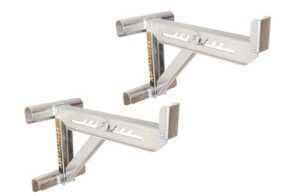
A ladder jack is another type of supported scaffold in which a platform rests on brackets connected to a ladder. This temporary structure is portable and cost-effective and is usually used for light tasks.
3. Mast Climbers
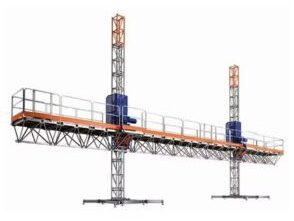
Mast climbers have movable support brackets and vertical poles that support a platform.
Mast climbers are the most common type of supported scaffold designed to carry heavy loads. They carry the weight of tools, materials, workers, and equipment at great heights.
4. Mobile
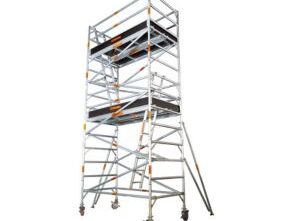
A mobile-supported scaffold features wheels and casters at its baseline so workers can move its platform from one place to another quite effortlessly. Mobile scaffolding systems are helpful when workers must cover a large area at a certain height. The wheels of mobile-supported scaffolds have locking mechanisms to provide a safe and secure platform for workers to use. These locks keep the scaffold in place while working and allow it to perform its task efficiently.
5. Wood Pole

A wood pole is a supported scaffold made of wood. The post has fixed connecting points where bearers, diagonals, and runners are interconnected at specified levels. This whole structure is designed for a task where workers must work in the same area for a long time. This structure is built for one-time use and usually meets specific project needs. The assembly and dismantling time of wood poles is high. Therefore, they are rarely used these days. There are two ways to erect a wood pole: single and double. Single wood pole-supported scaffold is fixed to a standing structure or wall, while a double-pole supported scaffold system is built independently of any other structure. Both types require runners, bearers, and standard braces in the overall framework.
6. Pump Jack

Pump jack is a popular type of supported scaffold. Its framework consists of a mobile platform with poles placed vertically. You can raise or lower its bracket to adjust this temporary structure, which offers a great deal of customization.
This scaffold features a moveable platform with poles set vertically. The temporary structure is also adjustable, as the brackets can be lowered or raised. Hence, construction teams use this scaffold simply because it can be customized. On the other hand, the scaffold is affordable compared to other types. In contrast, workers use a pump jack scaffold when the structure has to be adjusted repeatedly.
7. Specialty

Specialty is a special type of supported scaffold designed for a narrow and specific type of application. They are created for some unusual spaces and applications. The ten types of specialty-supported scaffolds are as follows:
- Plasterers’ scaffolds- Plasterers’s scaffold is designed for plastering tasks. It easy movement and quick access to walls and ceiling
- Decorators’ scaffolds – Decorator’s scaffold design for decorators. It is compact and lightweight and offers convenient access to detailed areas.
- Large-area scaffolds –Large-area scaffolds are designed to cover large areas when workers need to access multiple sections.
- Bricklayers’ square scaffolds—This scaffold is designed for bricklayers and offers a stable platform for workers handling bricks and mortar.
- Horse scaffolds – Horse scaffolds have saw-horse-like support and are designed for lightweight tasks such as interior design, ceiling work, and finishing.
- Form scaffolds—Form scaffolds are designed to support formwork for concrete structures. They support workers during the pouring and finishing of concrete.
- Carpenters’ bracket scaffolds -Carpenters’ bracket scaffolds are designed for carpeterners’ tasks such as framing and trimming. The framework has brackets attached to the building.
- Roof bracket scaffolds—Roof bracket scaffolds are attached directly to sloped roofs and are mainly used for installing, painting, and repairing roofs.
- Outrigger scaffolds—Outrigger scaffolds extend horizontally from the building structure and offer workers easy access to areas beyond the building’s footprint.
- Window jack scaffolds—Window jack scaffolds get support from a bracket attached to a window frame. They let the worker complete tasks such as window installation and repair.
8. Tube and Coupler

Tube and coupler scaffolds have a framework where platforms get support from tubes and are erected with coupling devices that join runners, braces, uprights, and bearers. This type of supported scaffold is very strong and, thereby, is used to carry heavy weight. It is ideal for projects where workers need to access different levels of high-rise buildings. Besides, tubes and couplers can be configured in many different directions.
What are the Benefits of Supported Scaffolds?
The six benefits of supported scaffolds are as follows:
- Enhanced Safety
- Versatility
- Increased Efficiency
- Cost-Effectiveness
- Stability
- Accessibility
1. Enhanced Safety
Supported scaffolds are erected on a solid base and integrated with various safety features such as guardrails, safe access systems, fall arrest systems, and toeboards. Therefore, this temporary structure prevents the risk of collapse and system imbalance. The secure anchor and structural stability ensure that workers experience high safety while performing tasks at various heights. Supported scaffold is erected and designed based on safety standards set by OSHA regulations. As a result, workers work on a safe and stable base that minimizes workplace accidents. Unsafe scaffolding can lead to accidents and potentially cause serious injuries and death.
2. Versatility
The most significant benefit of a supported scaffold is its versatility. Whether you want a temporary structure for a carpenter’s task or a complex industrial facility, you can easily design the structure according to your project requirements. It’s easy to customize the design for various tasks such as window installation, construction, maintenance, and cleaning. The supported scaffold’s modular design and adjustable components simplify the customization process for various indoor and outdoor projects.
3. Increased Efficiency
Another plus point of supported scaffolding is that it offers a safe and spacious platform for workers who can move tools and materials conveniently on it. The team can start work quickly, as assembly and disassembly don’t take much time. Supported scaffolding usually has ladders and integrated stairs that streamline workflow and boost overall efficiency.
4. Cost-Effectiveness
Another advantage of support scaffolds is their cost-effectiveness. They are reusable and durable, so investment in this scaffold yields a return for an extended period. Since it offers significant stability and safety, contractors can save money that they otherwise need to spend on medical bills, legal penalties, and fines. The rental and maintenance cost of supported scaffold is lower than other types of scaffold. You can enjoy long-term savings as minimal repair or replacement is needed from your side.
5. Stability
Supported scaffolds are anchored to a stable base, offering significant stability. The muscular build of this temporary structure offers high load-bearing capacity. High strength and stability make this temporary structure safe for workers who are handling heavy-duty projects.
6. Accessibility
A supported scaffold is designed with a wide platform that offers ample space to workers. Workers can move around easily and access hard-to-reach areas. The modular nature of this temporary structure makes it easy for workers to adjust or expand it as per project requirements or to access different areas. Supported scaffolds usually have built-in ladders and stairs that allow workers to maneuver conveniently.
What are the Disadvantages of Supported Scaffolds?
The five disadvantages of supported scaffolds are as follows:
- Labor-Intensive Assembly and Dismantling
- Space Requirements
- Limited Mobility
- Weight Restrictions
- Potential Safety Hazards
1. Labor-Intensive Assembly and Dismantling
The biggest drawback of the supported scaffold is its labor-intensive assembly and dismantling. Skilled laborers are required to erect this temporary structure, and assembly will take more time if a scaffold needs to be built for large structures. Labors must put together planks, connectors, frames, and braces, and design complexity requires careful planning. Safety hazards such as worker injury or structure collapse are risky if labor doesn’t handle the assembly and disassembly properly.
2. Space Requirements
Another problem with supported scaffolds is that they require significant ground space for installation. Therefore, they are not suitable for crowded or confined workspaces. If installed in urban areas, this temporary structure may disrupt ongoing operations or ground activities such as vehicle traffic or pedestrians. Once supported scaffolds aren’t in use, their frames and components require additional storage space.
3. Limited Mobility
Another disadvantage of a supported scaffold is its stationary nature. Once you set it all up, you can’t move it around. So, you can’t use it for projects where frequent repositioning is required. It’s hard to adjust supported scaffolds in limited access areas or tight spaces unless you customize a specialty scaffold.
4. Weight Restrictions
Another issue with supported scaffolds is their specific load-bearing capacity. If you don’t adhere to this capacity, you may damage the whole structure. When you plan to use them for heavy-duty work, you need to integrate supported scaffolds with additional reinforcement or specialized features that will increase your cost and project complexity. Overloading can also lead to wear and tear, thereby reducing their lifespan.
5. Potential Safety Hazards
Although supported scaffolds have multiple safety features, this temporary structure still poses various safety hazards. If laborers fail to secure their components, the structure may collapse or cause personal injury incidents. Many environmental factors, such as heavy wind or rain, increase safety risks for workers. The whole structure may collapse, damage, or fail unless regular inspections and maintenance are done.
What are the uses of Supported Scaffold?
The five uses of supported scaffolds are as follows:
- Construction
- Maintenance and Repairs
- Renovation Projects
- Industrial Applications
- Event Staging
1. Construction

Supported scaffolds are mainly used for various construction projects as they offer a highly secure platform for workers to handle their routine tasks at elevated heights. They are useful for plastering, window installation, roof cleaning, bricklaying, and exterior finishes. Workers can access hard-to-reach areas during their projects and can safely carry heavy materials and tools.
2. Maintenance and Repairs

Supported scaffolds prove quite helpful during maintenance and repair work for various industries. For example, you can use them for window repair, fixing damaged facades, building exterior cleaning, or handling structural damage. This scaffold allows workers to access different building areas without a ladder.
3. Renovation Projects

Supported scaffolds are also used for renovation projects. The best thing about this type of scaffold is that it allows workers to adjust the height, and this level of flexibility makes it an ideal choice for renovation projects. They can be used for updating architectural features, upgrading residential homes, restoring historic buildings, office remodeling, etc.
4. Industrial Applications

Supported scaffolds are useful in different industrial applications, such as cleaning, inspecting, and repairing oil refineries, power plants, and factory equipment. Their robust construction makes it easy for workers to move with heavy tools and equipment safely. Therefore, supported scaffolds are often built for maintaining turbines, inspecting pipes, and repairing industrial boilers.
5. Event Staging

Supported scaffolds are also used to create temporary structures for exhibitions, events, concerts, and other performances. They can be used as seating platforms, backdrop supports, stages, or lighting rigs during public events. Whether you want to create a platform for theater performance or a viewing deck for upcoming sports events, supported scaffolds can be customized to meet specific event staging requirements.
What are the Parts of the Supported Scaffold?
The seven parts of supported scaffolds are as follows:
- Outrigger beams
- Brackets
- Poles
- Legs
- Uprights
- Posts
- frames, or similar rigid support
1. Outrigger Beams

Outriggers are secured to the ground or any other stable surface, where they prevent the structure from tipping and counterbalance the overall weight of the scaffold. They provide lateral support to the scaffold and usually extend beyond the base structure. Outriggers are crucial in a situation when the footprint of the scaffold is limited, and an extended platform is required.
2. Brackets
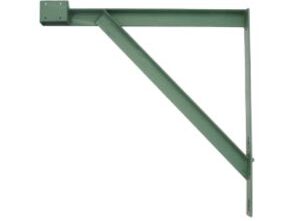
Brackets are horizontal support structures for planks and platforms. They are attached to frames or uprights of supported scaffolds. Brackets are made of metal and engineered to bear specific loads. They offer a safe base for workers to stand and handle tasks at elevated levels.
3. Poles
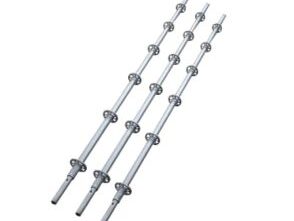
Poles are vertical components of supported scaffolds. They serve as a primary support that is connected to the base. Poles are made of steel or aluminum and are designed to bear heavy loads. Poles enhance the stability and integrity of the structure
4. Legs
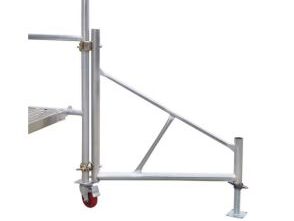
Legs are vertical supports that serve as the foundation of supported scaffolds by offering stability and perfect vertical alignment. They are adjustable and let you customize the height of the structure and level the supported scaffold on uneven ground. Once legs are properly adjusted, they prevent structural instability.
5. Uprights
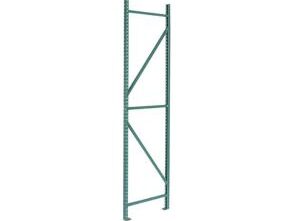
Uprights are vertical support members of supported scaffolds. They provide support to horizontal members such as brackets and platforms. Uprights are placed at specific angles in the overall framework to create a stable and balanced structure. They distribute the structure’s weight evenly.
6. Posts
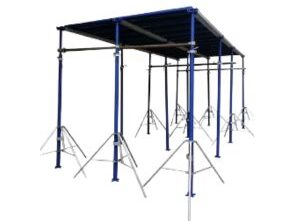
Posts are vertical supports connected to braces, platforms, and frames to create the backbone of the supported scaffold. They are sturdy and capable of handling lateral and vertical loads. Posts keep the structure rigid so that it can support multiple workers and heavy materials.
7. Frames or Similar Rigid Support
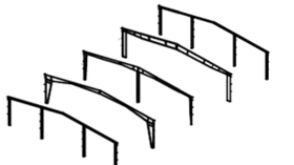
Frames are the main structural component of supported scaffolds. They hold the structure together and provide horizontal and diagonal stability. Rigid frames are made of metal and usually have built-in steps or ladders so workers can access various levels effortlessly. Frames or similar rigid support maintain the alignment of supported scaffolds and allow them to withstand heavy loads during various work activities.
What are the OSHA Regulations for Supported Scaffolds?
The nine OSHA regulations for supported scaffold are as follows:
- Load Support
- Full Planking
- Height-to-Base Width Ratio
- Footings
- Prohibited Supports
- Safe Access
- Prohibited Types
- Weather Conditions
- Guardrails and Personal Fall Arrest Systems
Load support: Supported scaffolds can hold up to four times their maximum intended load.
Full Planking: The platform of the supported scaffold shall be fully planked or
Height-to-Base Width Ratio: A supported scaffold must be secured at a height-to-base width ratio of over 4:1 through braces and guying ties.
Footings: Supported scaffolds must be erected on solid footings. The poles, legs, posts, frames, and uprights of the framework must bear one mud sill, base plates, or other stable and firm foundation.
Prohibited supports: A supported scaffold should not be supported by forklifts, unstable objects, lean-to scaffolds, shore scaffolds, front-end loaders, or similar equipment.
Safe Access: According to OSHA regulations, every employee must have secure access while erecting and dismantling supported scaffolds after a competent person inspects the site condition and determines the feasibility.
Prohibited Types: Sheore and lean-to scaffolds are strictly prohibited by OSHA
Weather conditions: As per OSHA regulations, workers are strictly prohibited from working on or from supported scaffolds during storms or high winds unless a competent person determines that it is safe for workers to work in such weather conditions. In that case, employees must use a windscreen and personal fall arrest system for protection. Windscreens shouldn’t be used if the scaffold isn’t secured against anticipated wind forces.
Guardrails and Personal Arrest Systems: As per OSHA guidelines, guardrails should be installed on supported scaffolds at heights over 10 feet. Guardrails can be between 35 and 45 inches high, while midrails can be placed at about half that height. Every employee more than 10 feet above a lower level shall be protected by guardrails or a personal fall arrest system, excluding those using single or two-point adjustable suspension scaffolds.
How is a float scaffold supported?
A float scaffold is supported by following four components:
- Platform and Bearers
- Suspension Ropes
- Rope Arrangement
- Personal Fall-Arrest Systems
1.Platform and Bearers
A platform is a working surface where workers stand and keep all the tools while performing their tasks. It is made of metal, wood, or other durable material. The size of the platform usually depends on project requirements. Bearers are rigid beams or planks that offer horizontal support beneath the platform. They are fastened to the platform and distribute weight across the scaffold. Platforms and bearers are the primary work surface that workers use. They provide structural stability.
2. Suspension Ropes
A float scaffold is supported by suspension ropes made of high-strength materials such as synthetic fibers or steel wires. These ropes are anchored to a secure structure above, such as a beam, overhead support, or roof. Suspension ropes hold the platform and bearer in place and let the scaffold float to a designated height.
3. Rope Arrangement
A float scaffold is supported by a rope arrangement, which depends on its size and load requirement. A single or double suspension system is in use. Ropes are secured to anchors and tensioned properly to maintain their security level.
4. Personal Fall-Arrest Systems
Float scaffolds also receive support from a personal fall arrest system (PFAS) that consists of a full-body harness, anchorage points, a lanyard, and a deceleration device. This system maintains worker safety and prevents falls. Workers wear the harness and attach it to a secure lifeline independent of suspension rope. The worker remains suspended, even if a floating scaffold fails.
What should not be used to Support a Scaffold?
You shouldn’t use the following four things to support a scaffold:
- Unstable Objects
- Front-End Loaders and Similar Equipment
- Forklifts
- Shore and Lean-To Scaffolds
1. Unstable Objects
Never use unstable objects such as loose blocks, bricks, makeshift wooden supports, barrels, etc to support a scaffold. These objects can shift, collapse, or topple, leading to failure and instability of a structure. Scaffolds are not erected on snow, ice, or other slippery surfaces. They can’t support the weight of workers, scaffolds, or material. Safety standards prohibit using unstable objects to support scaffolds and emphasize using a stable foundation.
2. Front-End Loaders and Similar Equipment
You should never support a scaffold with construction equipment such as front-end loaders, excavator buckets, or similar equipment. This equipment isn’t designed to support scaffolds and can be moved unexpectedly to put the complete structure at risk. Safety can be compromised if equipment vibrates or weight imbalances. The problem with front-end loaders and similar equipment is that they lack proper anchors and the static stability you need to support a scaffold. So, using such equipment is a dangerous choice to make.
3. Forklifts
Forklifts should never be used to support a scaffold. Although they are mobile and can be moved easily, they are not designed to bear the loads that scaffold systems impose. Therefore, they may tip over the whole structure if improperly set or overloaded. Forklifts are prohibited from being used as scaffold supports as they don’t offer a stable base.
4. Shore and Lean-To Scaffolds
Shore scaffold should never be used as a direct support system of the scaffold. They are used as temporary support during construction but are not designed to handle the loads and movements connected with the scaffold. Lean-to-scaffolds should never be used to support a scaffold. This type of scaffold leans against a wall or structure and doesn’t have any independent support. Since they rely on the leaning surface’s structural integrity, they are not stable enough to support a scaffold. They post a serious risk of detachment and tip-over.
What is the Diagram of Supported Scaffolding?







